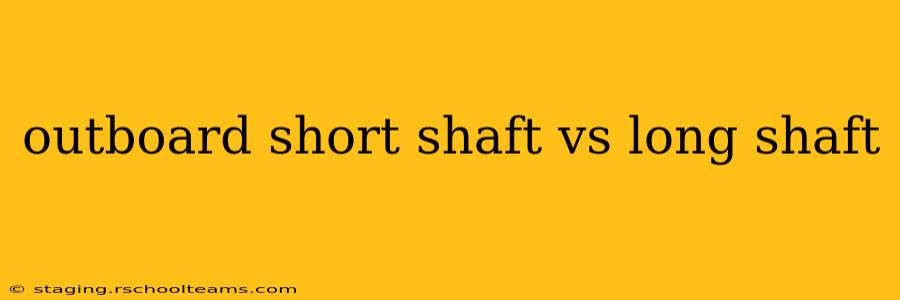Choosing the correct outboard motor shaft length is crucial for the safe and efficient operation of your boat. The wrong length can lead to propeller cavitation, damage to your motor, or even prevent you from using your boat properly. This guide will help you understand the key differences between short and long shaft outboards, helping you make the informed decision that's best for your needs.
What is the difference between a short shaft and a long shaft outboard?
The primary difference lies, as the names suggest, in the length of the drive shaft connecting the motor to the propeller. This seemingly small detail significantly impacts the motor's installation and overall performance. Short shafts are typically 15 inches in length, while long shafts measure 20 inches. This seemingly small difference is vital when considering the boat's transom height.
How do I know if I need a short shaft or a long shaft outboard?
Determining whether you need a short or long shaft outboard hinges entirely on your boat's transom height. The transom is the back of the boat, where the outboard motor is mounted. Incorrect shaft length can cause serious problems, so accurate measurement is essential.
Measuring Your Transom Height
To determine your transom height, measure from the bottom of the boat's hull to the top of the transom, where the outboard would be mounted. This measurement should be taken with the boat sitting level on dry land or a stable trailer. Remember to account for any existing mounting brackets or hardware.
- 15 inches (or less): Typically indicates a need for a short shaft outboard.
- 20 inches: Typically indicates a need for a long shaft outboard.
What happens if I install the wrong shaft length?
Installing the incorrect shaft length can have serious consequences:
-
Short shaft on a boat needing a long shaft: The propeller will not fully submerge, leading to ventilation (cavitation), reduced performance, and potential damage to the motor's lower unit. You'll also likely experience reduced speed and poor handling.
-
Long shaft on a boat needing a short shaft: The propeller will be excessively submerged. This can cause the propeller to hit underwater obstacles more easily and may also lead to excessive strain on the motor.
What are the advantages and disadvantages of each?
While the primary difference is transom height compatibility, other factors subtly influence your choice.
Short Shaft Outboards:
Advantages:
- Generally less expensive: Short shaft outboards are often cheaper than long shaft equivalents.
- Lighter weight: This translates to better fuel economy in some cases.
Disadvantages:
- Limited to boats with low transom heights: Inappropriate for most larger boats.
- Increased risk of ventilation: More prone to cavitation, especially at higher speeds or in rough water.
Long Shaft Outboards:
Advantages:
- Suitable for deeper hulls: Provides proper propeller submergence for better performance and prevents ventilation.
- Better performance in rough water: Maintains efficient propeller operation even when dealing with waves.
Disadvantages:
- More expensive: Generally more costly than short shaft outboards.
- Heavier weight: Can slightly impact fuel economy compared to shorter shafts.
Can I use a jack plate to adjust transom height?
Yes, jack plates are devices that allow you to adjust the height of your outboard motor. This can be useful if you're slightly outside the recommended transom height range for a given shaft length, offering flexibility and performance optimization. However, proper installation and careful consideration are crucial for safe and effective use. Always consult a qualified marine mechanic for jack plate installation.
How do I find the correct shaft length for my boat?
The best way to determine the correct shaft length is by accurately measuring your boat's transom height, as described above. If you are unsure, consult your boat's owner's manual or a qualified marine mechanic. They can provide expert guidance to ensure your outboard is correctly matched to your boat for optimal safety and performance. Don't hesitate to seek professional help; a correct installation is crucial for your safety and the longevity of your equipment.
